Escape
Politics

Throughout the country, political analyst A.O. Hirschman explains, there are only three different options for how to behave: be loyal, protest, or leave. In the Eastern-bloc countries, protesting was illegal, and leaving (i.e. "voting with your feet") was too. The workers’ paradise was being built, to escape it was to betray it. The "Iron Curtain" (Churchill) was more than just a figure of speech: the Berlin Wall was equipped with long stretches of barbed wire that delineated minefields watched over by guard dogs, soldiers who were authorized to shoot and even automatic shooting machines (the 171 people who died at the Wall provide sad proof of their combined efficiency). The no-man’s-land ran from the Soviet Union’s carefully watched border with Finland to the fences separating Czechoslovakia and Hungary from Austria (which were reinforced after the uprisings of 1956 and 1968). There were even watchtowers and barbed wire between Socialist countries. From 1946 to 1961, the year the Wall was built, thousands of East Germans escaped towards the West, usually via Berlin on the subway or S-Bahn train. After the Wall went up, it took more complicated plots, tunnels, money, courage and guides or “passers”. In Poland, graphic designers made themselves fake I.D. In Finland a dissident escaped with his children on a small boat. Some people went via Yugoslavia, with its open borders. Fear of defection haunted anyone responsible for group travel or sporting events, which were under strict surveillance by security services (Stasi, KGB, etc.). Anyone who failed in their attempt to escape was sentenced to a long prison term for "escaping the Republic" (East Germany) or "border violation." Reliable statistics about the number of actual and attempted escapes are not available. In the USSR, the fate of Jews who were refused permission to emigrate to Israel (“refuseniks") attracted international attention. In 1976, the dissident Natan Sharansky became their spokesman – defending both the laypeople who wanted to escape Soviet anti-Semitism and religious believers who wanted to get to the Holy Land. He was sentenced to 13 years of hard labor, and released to Berlin in 1986. In the West (Berlin, London, Paris), small émigré communities supported each other in exile, and helped those they had left behind by sending money, books, information, samizdat etc. The most influential of the émigrés was the millionaire George Soros, whose background was Hungarian, and who created a major aid network for intellectuals, dissidents and others who opposed Eastern European regimes (Soros Foundation). For those who couldn’t get through the Iron Curtain, there was the internal emigration option, i.e. escaping Socialist reality by whatever means possible. Some went back to the land as self-sufficient farmers or shepherds; others became poets or musicians whose subject matter avoided anything political. By the late 1980s, political differences between Eastern countries encouraged East Germans in particular to try their chances with their more reform-minded neighbors, like Czechoslovakia and Hungary (abolition of their Iron Curtain on May 2, 1989, "Pan-European Picnic" on August 19, 1989). West German embassies in these countries became such important transit stations that it created a major problem for East Germany, and contributed to the fall of the Wall on November 9, 1989.
Archive
Cutting the Iron Curtain
June 27, 1989. Alois Mock, the Austrian Minister of Foreign Affairs, and his Hungarian counterpart, Gyula Horn, brandishing special wire-cutters, symbolically cut through the barbed wire that had separated their two countries for four decades, at a spot n
country: People's Republic of Hungary / year:
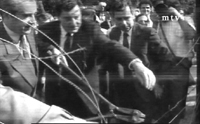
June 27, 1989. Alois Mock, the Austrian Minister of Foreign Affairs, and his Hungarian counterpart, Gyula Horn, brandishing special wire-cutters, symbolically cut through the barbed wire that had separated their two countries for four decades, at a spot not far from the city of Sopron. This first opening in the heretofore hermetically sealed border wasn’t legally recognized until September 10, 1989. Dismantling the Iron Curtain had actually begun on May 2, 1989, when the Hungarian government – the most "Gorbatchevian" of the Eastern European regimes, raised the Iron Curtain along the 160 miles (260 km) of their border with Austria. In fact, Hungarian border guards had discreetly stopped maintaining their stretch of the Iron Curtain in 1986, considering that it was both obsolete and costly to maintain. It had actually been hard to find an intact section for the two ministers to snip for the news cameras. Internally, the Soviets had let it be known that they would no longer back up their decisions with military might. It was the end of the "Brezhnev Doctrine.” The wire-cutting had a domino effect. From then on, East Germans could use the pretext of vacationing on Lake Balaton to take advantage of the first holes in the Curtain to escape to the West. It would lead to the Fall of the Wall in just a few months.
The Wall’s Victims
“Anti-Fascist protection wall” according to East Germany; “Wall of Shame” for the West – and Wall of Death, too. By the end, this complex military installation included two 12-foot- high (3.6 m.) walls with walkways, 302 watch towers, an alarm system, 14,
country: German Democratic Republic / year:
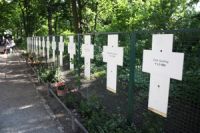
“Anti-Fascist protection wall” according to East Germany; “Wall of Shame” for the West – and Wall of Death, too. By the end, this complex military installation included two 12-foot- high (3.6 m.) walls with walkways, 302 watch towers, an alarm system, 14,000 guards, 600 watch dogs and miles and miles of barbed wire. Some 160 East Germans lost their lives trying to cross it: East German border guards and Soviet soldiers were under orders to shoot fugitives. The total number of casualties along the border is at least 421, although some victims were hushed up in East Germany. Günter Litfin (age 24) was the first, on August 24, 1961, eleven days after the border was closed. Chris Gueffroy was the Wall’s last victim, on February 5, 1989. These crosses near the Reichstag commemorate some of those who died attempting to reach freedom.
Let’s Go to Israel
Group shot of refuseniks. Back row: Vitaly Rubin, Vladimir Slepak, Lev Ovsisscher, Alexander Druk, Yossi Beilin. Front row: Natan Sharansky, Ida Nudel, Alexander Lerner.
country: Soviet Union / year:
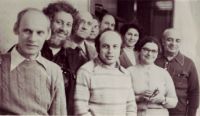
Group shot of refuseniks. Back row: Vitaly Rubin, Vladimir Slepak, Lev Ovsisscher, Alexander Druk, Yossi Beilin. Front row: Natan Sharansky, Ida Nudel, Alexander Lerner. Between traditional anti-Semitism, state-sanctioned anti-Zionism and the impossibility of living within the rules of ultra-Orthodoxy, daily life was tremendously difficult for Jews in the Soviet Union. After the Six Day War in 1967, a great number of Soviet Jews requested emigration visas. This entered them into a vicious circle: now they could also be accused of disloyalty to their Soviet homeland. Most of these requests were refused (hence the term “refuseniks”), either on the spot or after an interminable waiting period while their file was being examined. Some were arrested, others forced to leave their jobs – which left them open to accusations of “social parasitism.” Natan Sharansky, the dissident Sakharov’s former secretary, became the leader of the movement in 1976. He was sentenced to 13 years of hard labor in 1977, and released in West Berlin in 1986 à Berlin-Ouest.
First tear in the Iron Curtain
August 19, 1989. At the Austro-Hungarian border, near the Hungarian city of Sopron, the International Pan-European Union, Otto de Habsburg’s NGO, organized a symbolic, peaceful demonstration that was well-covered by the media (photo).
country: People's Republic of Hungary / year:
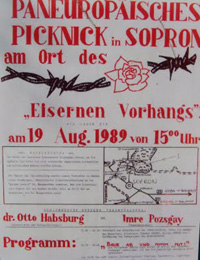
August 19, 1989. At the Austro-Hungarian border, near the Hungarian city of Sopron, the International Pan-European Union, Otto de Habsburg’s NGO, organized a symbolic, peaceful demonstration that was well-covered by the media (photo). Czechoslovakia, GDR and Hungary have been wobbling for months under pressure from their own populations. Two months earlier, the Ministers of Foreign Affairs from the two countries had cut through the border defenses separating them to symbolize Hungary’s decision to begin dismantling the Iron Curtain. On this day, the border guard stations were opened for three hours. Some 600 East German citizens took advantage of the event to escape to the West. They were spared by the border guards, who were still under orders to shoot fugitives, but who refused to do it, “out of human kindness.” Annual festivities on the spot celebrate the historical event.
Interview with an East German woman who wants to leave her country
Living in a Communist country is supposed to be a dream come true for everyone in the Eastern bloc
country: German Democratic Republic / year:
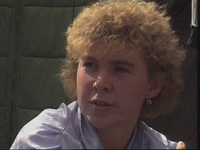
Living in a Communist country is supposed to be a dream come true for everyone in the Eastern bloc. So requesting an exit visa is seen as a step towards betrayal. The methods for pressuring people to stay were varied: the relatives of a person who requested a visa could be refused a spot at university. The person, and their relatives, could be forced to quit their job, even though most of the requests were denied, unemployment was illegal, and those who had no jobs could be charged as "social parasites." Nevertheless, by the late 1980s, the number of requests was increasing, particularly among young East Germans.
East German Exodus
In the summer of 1989, several waves of East German fugitives
country: Czechoslovakia / year:
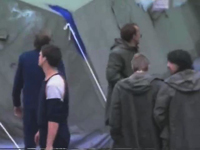
In the summer of 1989, several waves of East German fugitives (the number has been estimated at up to 15,000 refugees) overwhelmed the West German embassy in Prague, demanding to be admitted into West Germany. More than half of them had to sleep outside on the ground; others clambered over the garden wall. Men slept in the hallways, on the stairway or in tents in the garden; women and children in the evacuated offices. The garden, muddy from heavy rain, was full to bursting, there were logistical problems and the embassy seemed to be on the verge of a humanitarian crisis. Budapest had closed its border with Austria, where escape had been possible for a few weeks. By late summer, Czechoslovakia was the last country East Germany had a no-visa, no-passport policy with. Finally, on September 30, 1989, the Federal (West) German Minister of Foreign Affairs went to Prague and informed the 4,000 East German refugees at the embassy that they could enter West Germany. The refugees threw away the keys to their East German homes and cars to symbolize their refusal ever to return to East Germany. A few hours later, on the night of September 30 to October 1, several special trains left Prague via Dresden for Hof, West Germany. To commemorate the event, a bronze statue by David Černý, of a Trabant car with feet instead of tires, is now installed in the garden of the Embassy.